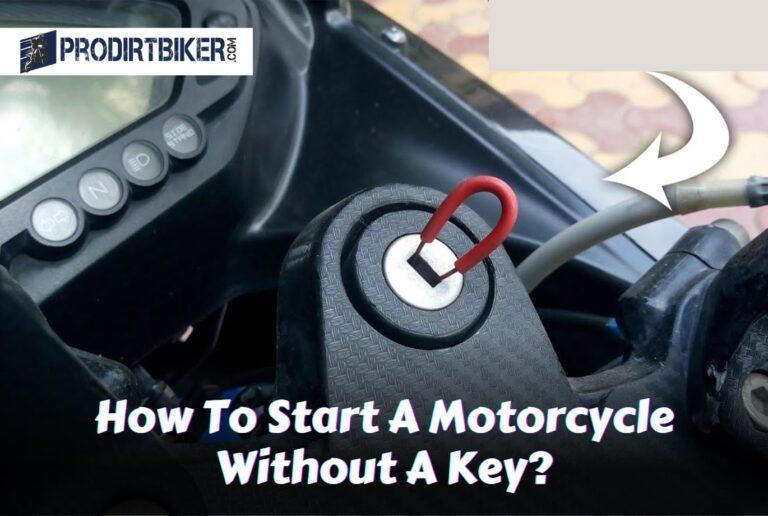How To Break In A New Dirt Bike: Master the Art for Top Performance!
To break in a new dirt bike, it’s important to avoid taking it directly from the showroom onto the trail. Breaking in your bike ensures its long-term life and prevents any potential harm to the engine on the first run.
By following proper break-in procedures, you can avoid pushing the engine to its limits on day one and ensure optimal performance. Breaking in a new dirt bike is an essential step in maintaining its longevity and performance. Let’s explore the process of breaking in a dirt bike engine and why it’s necessary for a smooth and reliable ride.

Credit: www.outdoorgearlab.com
Why Break In A New Dirt Bike?
Importance of Breaking in a New Dirt Bike
When it comes to purchasing a brand new dirt bike, it’s important to understand the significance of breaking it in properly. Breaking in a new dirt bike is necessary to avoid potential challenges and damage, while also ensuring long-term performance and longevity. Without a proper break-in process, you could experience engine issues, decreased performance, and even premature wear and tear on important components.
Avoiding Potential Challenges and Damage
By taking the time to break in your new dirt bike, you can avoid potential challenges and costly damage. During the break-in period, the engine parts need to adjust and adapt to the high-speed, high-stress environment they’ll be operating in. Without this adjustment period, the engine components can experience excessive wear and tear, leading to decreased performance and potentially expensive repairs.
To avoid potential challenges and damage, it’s essential to follow the manufacturer’s recommended break-in procedure. This typically involves gradually increasing the engine’s speed and load over a certain number of hours or miles. By gradually introducing more stress to the engine, you allow the components to properly seat and mate together, ensuring optimal performance and reliability in the long run.
Ensuring Long-Term Performance and Longevity
Properly breaking in your new dirt bike is the key to ensuring its long-term performance and longevity. The break-in period allows the engine components to wear evenly and smoothly, reducing the risk of premature failure and maximizing the bike’s overall lifespan.
By following the manufacturer’s guidelines for breaking in your dirt bike, you can also improve the bike’s overall performance. This is because the break-in process allows the engine to achieve optimal power output and efficiency. It allows the piston rings to properly seat against the cylinder walls, resulting in better compression and improved power delivery.
To ensure long-term performance and longevity, it’s important to take it easy on your new dirt bike during the break-in period. Avoid excessive revving and prolonged high-speed riding until the engine has had a chance to properly break in. This will help prevent overheating and excessive wear, ultimately extending the life of your dirt bike.
In conclusion, breaking in a new dirt bike is of utmost importance for several reasons. It helps avoid potential challenges and damage, ensures long-term performance and longevity, and maximizes the overall lifespan of your bike. By following the manufacturer’s recommended break-in procedure, you can set yourself up for a successful and enjoyable riding experience with your new dirt bike.
The Break-In Routine For A New Dirt Bike
Step-by-step guide to breaking in a new dirt bike
Breaking in a new dirt bike is an essential step to ensure its longevity and optimal performance. By following a proper break-in routine, you can prevent premature wear and damage to the engine. Here is a step-by-step guide to breaking in a new dirt bike:
Initial inspection and prep
Before starting the break-in process, it’s important to conduct an initial inspection of your new dirt bike. Check for any loose bolts or parts. Ensure that the tires are properly inflated and the chain is properly lubricated. Once you have completed the inspection, you are ready to proceed with the break-in process.
Start-up and warm-up procedure
To begin, start the dirt bike and let it idle for a few minutes. This allows the engine oil to warm up and circulate throughout the engine. During this time, avoid revving the engine or putting any load on it.
Gradual throttle and RPM increase
After the warm-up period, you can begin gradually increasing the throttle and RPM of the dirt bike. Start with gentle acceleration and avoid rapid throttle opening. Gradually increase the speed and RPM over multiple sessions. This helps the engine components to gradually settle into their proper positions.
Varying speeds and engine load
Once you have become comfortable with increasing throttle and RPM, it’s important to vary your speeds and engine load during the break-in process. This can be accomplished by taking the dirt bike on different types of terrain and adjusting the throttle accordingly. By varying the engine load, you allow different parts of the engine to experience different stress levels, promoting overall engine break-in.
Cool down period
After each riding session, it’s crucial to allow the engine to cool down properly. This can be done by letting the dirt bike idle for a few minutes before shutting it off. Avoid shutting off the engine immediately after high-speed or intense riding. Allowing the engine to cool down helps prevent overheating and promotes proper lubrication throughout the engine.
By following these steps and adhering to a proper break-in routine, you can ensure the longevity and optimal performance of your new dirt bike. Remember to always refer to the manufacturer’s guidelines and recommendations for specific break-in procedures.
Breaking In Specific Dirt Bike Parts
Breaking in the Clutch
Properly breaking in the clutch is crucial for the smooth operation and longevity of your dirt bike. The clutch is an essential part of the bike’s transmission system, allowing you to smoothly shift gears and control the power delivery. To ensure a long-lasting clutch, follow these steps:
- Proper adjustment and engagement: Before riding your new dirt bike, make sure the clutch lever has the correct amount of free play. This can be adjusted using the adjustment screw located near the clutch lever. Additionally, ensure that the clutch engages smoothly and doesn’t slip or grab excessively.
- Gradual clutch engagement exercises: During the break-in period, practice gradual clutch engagement exercises to help the clutch plates bed in properly. Start by engaging the clutch slowly and smoothly and gradually increase the speed and force of engagement over time. This will help the clutch plates wear evenly and prevent premature failure.
Breaking in the Piston and Rings
The piston and rings are crucial components in the engine of your dirt bike. Properly breaking them in will ensure optimal performance and prevent damage. Here’s what you need to know:
- Understanding the piston break-in process: When a new piston and rings are installed, they need time to properly seat and create a seal within the cylinder. During the break-in process, the piston and rings will wear into the cylinder walls, creating the necessary seal for optimal compression and power.
- Recommended RPM limits during break-in: It’s important to follow the manufacturer’s recommended RPM limits during the break-in period. This will prevent excessive loading and heat buildup in the engine, allowing the piston and rings to wear in gradually and evenly.
Breaking in the 2-Stroke Engine
2-stroke engines require specific care and attention when it comes to break-in. Follow these steps to ensure proper break-in of your 2-stroke dirt bike engine:
- Mixing fuel and oil properly: Proper mixing of fuel and oil is crucial for the lubrication of the engine. Always follow the manufacturer’s recommended fuel to oil ratio to ensure proper lubrication and prevent engine damage.
- Importance of proper jetting: Jetting refers to the carburetor tuning that determines the fuel and air mixture. Proper jetting is crucial during the break-in period to prevent lean conditions that can lead to engine damage. Consult your dirt bike’s manual or a professional mechanic for proper jetting recommendations.
- Gradual power and RPM increase: Similar to the piston break-in process, it’s important to gradually increase the power and RPM of your 2-stroke engine during the break-in period. This allows the piston and rings to wear in gradually and ensures proper seating and sealing within the cylinder.
Common Mistakes To Avoid During The Break-In Process
When it comes to breaking in a new dirt bike, there are several common mistakes that riders often make. These mistakes can not only affect the performance and longevity of your bike, but they can also lead to costly repairs down the line. To ensure a smooth break-in process, it is important to avoid the following common mistakes:
Over-revving the engine
One of the most common mistakes riders make during the break-in process is over-revving the engine. It can be tempting to unleash the full power of your new bike right from the start, but this can cause damage to the engine components. Over-revving the engine puts unnecessary stress on the piston, cylinder walls, and other vital parts. To avoid this mistake, it is important to stick to the manufacturer’s recommended RPM limits during the break-in period.
Ignoring manufacturer guidelines
Another common mistake is ignoring the manufacturer’s guidelines for the break-in process. Every dirt bike is different, and manufacturers provide specific instructions on how to properly break in their bikes. These guidelines may include recommendations on RPM limits, time intervals for oil changes, and specific riding techniques. Ignoring these guidelines can result in premature engine wear and reduced performance. It is essential to carefully read and follow the manufacturer’s instructions to ensure a successful break-in.
Skipping or rushing the break-in procedure
Perhaps one of the biggest mistakes riders make is skipping or rushing through the break-in procedure. Some riders may believe that breaking in a new dirt bike is unnecessary and proceed to push the bike to its limits right away. However, this can lead to severe engine damage and even engine failure in some cases. On the other hand, some riders may rush the break-in process by not properly following the recommended procedures. It is crucial to take the time to break in your new dirt bike correctly, allowing the engine components to properly mate and wear in. This involves gradually increasing the RPMs and avoiding high-stress riding during the initial hours of use.
By avoiding these common mistakes, you can ensure that your new dirt bike is properly broken in and ready for years of reliable performance. Taking the time to follow the manufacturer’s guidelines and being patient during the break-in process will pay off in the long run, resulting in a bike that performs at its best and lasts for many riding seasons.
Maintaining A Newly Broken-In Dirt Bike
Once you have successfully broken in your new dirt bike, it is crucial to maintain it properly to ensure optimal performance and longevity. Regular maintenance checks, oil changes, filter cleaning, and post-break-in performance evaluations are essential tasks that should not be overlooked. By following these steps, you can keep your newly broken-in dirt bike in top shape for many thrilling rides to come.
Follow-up maintenance and checks
After breaking in your dirt bike, it is essential to perform follow-up maintenance and checks to catch any potential issues early on. This will help prevent major problems and ensure that your bike continues to run smoothly. Here are some key maintenance tasks you should include:
- Inspect the spark plug and replace it if necessary to ensure optimal ignition.
- Check the air filter regularly and clean or replace it as needed to maintain proper airflow and prevent engine damage.
- Inspect the chain tension and lubricate it to ensure smooth and efficient power transfer.
- Check the brake pads for wear and replace them if they are worn down.
- Inspect the tires for any signs of damage or wear and adjust the tire pressure accordingly.
Regular oil changes and filter cleaning
Regular oil changes and filter cleaning are crucial for maintaining the performance and longevity of your dirt bike. The oil lubricates the engine and helps prevent friction and overheating, while the filter removes impurities from the oil to ensure its effectiveness. Follow these steps for proper oil changes and filter cleaning:
- Warm up the engine by idling the bike for a few minutes.
- Place an oil pan beneath the drain plug and remove the plug to drain the old oil.
- Replace the drain plug and remove the oil filter.
- Install a new oil filter and tighten it securely.
- Refill the engine with the recommended type and amount of oil.
- Start the engine and let it idle for a few minutes to distribute the fresh oil throughout the engine.
- Check the oil level and adjust if necessary.
Cleaning the air filter is also crucial to prevent dirt and debris from entering the engine. Follow these steps to clean the air filter:
- Remove the air filter from the bike.
- Clean it with compressed air or wash it with mild soap and water.
- Allow the filter to fully dry before reinstallation.
- Apply filter oil to the filter to enhance its effectiveness in trapping dirt and debris.
Post-break-in performance evaluation
Once your dirt bike has been broken in and you have performed the necessary maintenance tasks, it’s time to evaluate its performance. This evaluation will help you identify any areas that may require further attention or adjustments. Here are some key points to consider during the post-break-in performance evaluation:
- Pay attention to any unusual noises or vibrations that may indicate a problem.
- Monitor the bike’s acceleration, top speed, and overall responsiveness.
- Check if the bike is reaching and maintaining the proper operating temperature.
- Evaluate the bike’s handling and suspension performance.
- Assess the fuel efficiency to ensure the bike is running optimally.
By conducting a thorough post-break-in performance evaluation, you can identify any issues early on and address them promptly, ensuring that your dirt bike performs at its best.
Frequently Asked Questions Of How To Break In A New Dirt Bike
Do Dirt Bikes Need To Be Broken In?
Yes, dirt bikes need to be broken in to ensure their long-term lifespan and prevent potential damage. Avoid taking your bike directly onto the trail from the showroom as it can cause challenges or harm the bike. It’s best to follow the recommended break-in routine to protect your engine.
How Do You Break In A New 4 Stroke Engine?
To break in a new 4 stroke engine, it’s important to take it easy at first. Avoid pushing the engine to its limits right away. Gradually increase the throttle and vary the engine speed during the first few rides. This process allows the engine components to settle and helps ensure a long-lasting engine life.
How Long Does It Take To Get Comfortable On A Dirt Bike?
It takes a few sessions to feel comfortable on a dirt bike, but becoming a skilled rider on rough terrains takes much longer. It’s important to break in your new dirt bike to ensure its longevity instead of pushing the engine to the limit on the first ride.
How Do You Run In A Brand New Dirt Bike?
To run in a brand new dirt bike, it is essential to break it in properly. Avoid taking it straight to the trail and risking damage. Instead, follow these steps to ensure your bike has a long and healthy life.
How Long Should I Break In My New Dirt Bike Engine?
To properly break in your new dirt bike engine, it is recommended to ride it gently for the first 8-10 hours or as specified in the manufacturer’s guidelines.
Conclusion
Breaking in a new dirt bike is crucial for its long-term performance and durability. By taking the time to properly break in your bike, you can avoid potential challenges or damage that may arise from pushing the engine to its limits too soon.
Whether you’re a beginner or an experienced rider, giving your dirt bike the necessary break-in period will ensure a smoother and more enjoyable riding experience in the future. So, take the time to follow the recommended break-in steps and give your new dirt bike the care it deserves.
Happy riding!




